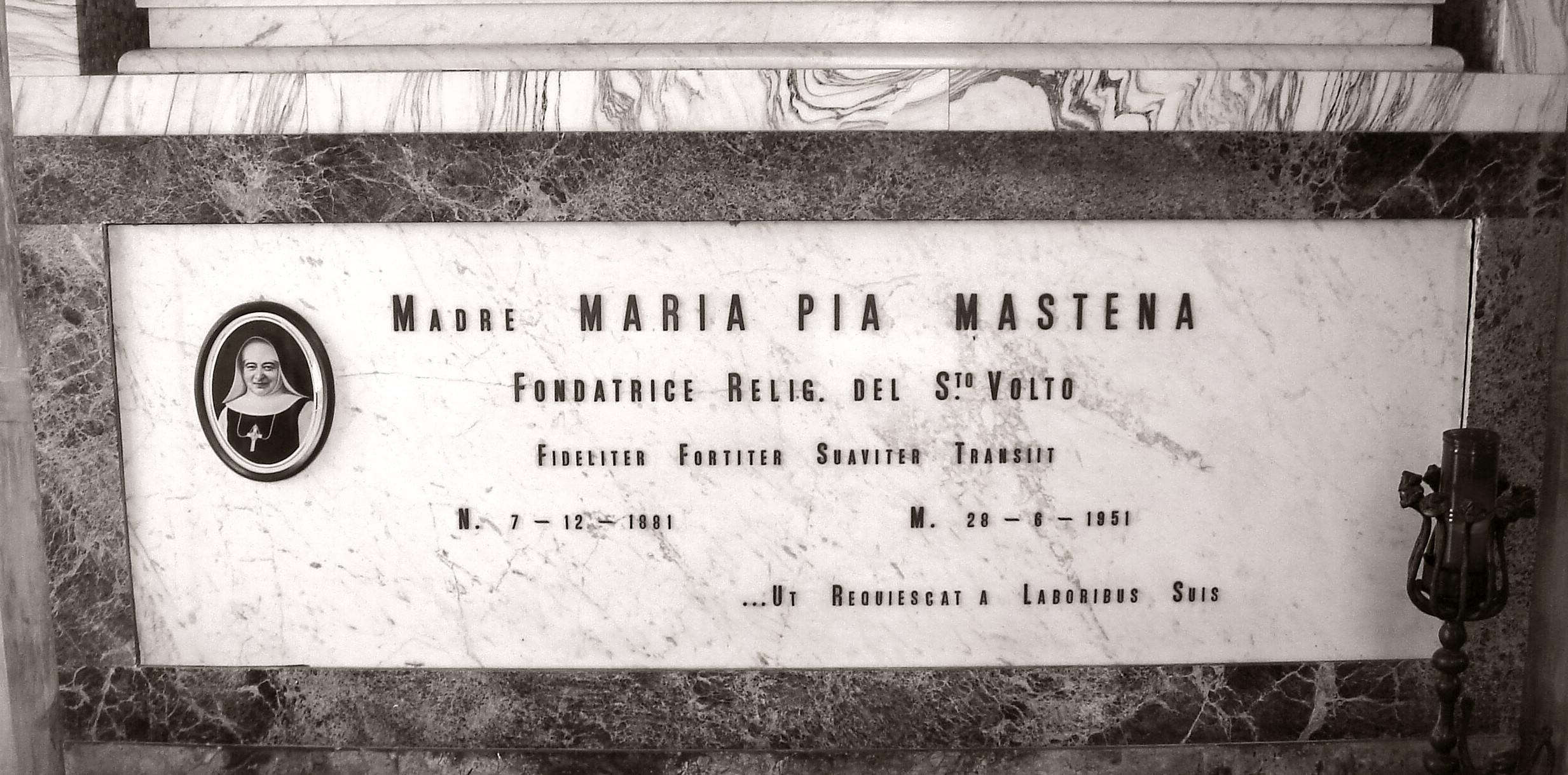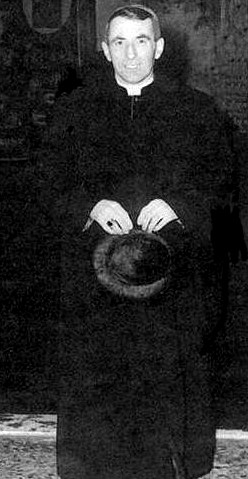|
Sisters Of The Holy Face
The Sisters of the Holy Face (''Sororum a Sancto Vultu'') (also known as the "Institute of Sisters of the Holy Countenance") is a Roman Catholic religious organization for women. The order was founded in San Fior in Treviso Italy in 1930 by Blessed Maria Pia Mastena (1881-1951). The members of the order use the abbreviation SSV after their names.Annuario Pontificio 2007, Libreria Editrice Vaticana, Vatican City, page 1723 History Mastena joined the Sisters of Mercy of Verona and obtained her teaching license, but after World War I left to become a cloistered Cistercian nun. Shortly after, on advise of her spiritual director, she left the convent and resumed teaching. She opened a nursery school and soup kitchen. In 1930 she organized a small group called Pious Rescue which was aimed at assisting poor children and teaching them a trade. She was soon joined by other young women. Despite the opposition from some local priests, the congregation was initially approved by the Roman ... [...More Info...] [...Related Items...] OR: [Wikipedia] [Google] [Baidu] |
Roman Catholic
Roman or Romans most often refers to: *Rome, the capital city of Italy *Ancient Rome, Roman civilization from 8th century BC to 5th century AD *Roman people, the people of ancient Rome *'' Epistle to the Romans'', shortened to ''Romans'', a letter in the New Testament of the Christian Bible Roman or Romans may also refer to: Arts and entertainment Music * Romans (band), a Japanese pop group * ''Roman'' (album), by Sound Horizon, 2006 * ''Roman'' (EP), by Teen Top, 2011 *" Roman (My Dear Boy)", a 2004 single by Morning Musume Film and television * Film Roman, an American animation studio * ''Roman'' (film), a 2006 American suspense-horror film * ''Romans'' (2013 film), an Indian Malayalam comedy film * ''Romans'' (2017 film), a British drama film * ''The Romans'' (''Doctor Who''), a serial in British TV series People *Roman (given name), a given name, including a list of people and fictional characters *Roman (surname), including a list of people named Roman or Romans *Ῥωμ� ... [...More Info...] [...Related Items...] OR: [Wikipedia] [Google] [Baidu] |
San Fior
San Fior is a ''comune'' (municipality) in the Province of Treviso in the Italian region Veneto, located about north of Venice and about northeast of Treviso. As of 31 December 2004, it had a population of 6,357 and an area of .All demographics and other statistics: Italian statistical institute Istat. San Fior borders the following municipalities: Codogné, Colle Umberto, Conegliano, Godega di Sant'Urbano, San Vendemiano. Frazioni San Fior is divided into three villages: the principal town is San Fior (or San Fior di Sopra); the south frazione is San Fior di Sotto and the north frazione is Castello Roganzuolo Castello Roganzuolo (''Castél'' in Venetian language) is a frazione of San Fior ''comune'' (municipality) in the Province of Treviso in the Italian region Veneto, located on Conegliano hills (famous for productions of wine, especially prosecco) .... Demographic evolution Colors= id:lightgrey value:gray(0.9) id:darkgrey value:gray(0.8) id:sfondo value:rgb ... [...More Info...] [...Related Items...] OR: [Wikipedia] [Google] [Baidu] |
Treviso
Treviso ( , ; vec, Trevixo) is a city and ''comune'' in the Veneto region of northern Italy. It is the capital of the province of Treviso and the municipality has 84,669 inhabitants (as of September 2017). Some 3,000 live within the Venetian walls (''le Mura'') or in the historical and monumental center; some 80,000 live in the urban center while the city hinterland has a population of approximately 170,000. The city is home to the headquarters of clothing retailer Benetton Group, Benetton, Sisley, Stefanel, Geox, Diadora and Lotto Sport Italia, appliance maker De'Longhi, and bicycle maker Pinarello. Treviso is also known for being the original production area of Prosecco wine and radicchio, and is thought to have been the origin of the popular Italian dessert Tiramisù. History Ancient era Some believe that Treviso derived its name from the Celtic word "tarvos" mixed with the Latin ending "isium" forming "Tarvisium", of the tarvos. Tarvos means bull in Celtic mytho ... [...More Info...] [...Related Items...] OR: [Wikipedia] [Google] [Baidu] |
Maria Pia Mastena
Blessed Maria Pia Mastena (7 December 1881 - 28 June 1951) - born Teresa Maria - was an Italian Roman Catholic professed religious and the founder of the Religious Sisters of the Holy Face. Mastena fostered a deep devotion to the Holy Face of Jesus and tried to promote that devotion to others in her religious career as a nun. Mastena first desired the contemplative life but was denied this after she entered the convent since it was not a cloister. Instead she dedicated herself to teaching in several Italian cities after having left another convent and another religious order when she deemed contemplative life was not the life she felt God wanted for her. Her labors were dedicated instead to consolidating her new religious order which began to grow after World War II until her sudden death in 1951. Mastena's beatification process opened on 23 June 1990 under Pope John Paul II who later named Mastena as Venerable in 2002 after having confirmed her heroic virtue. Her beatification w ... [...More Info...] [...Related Items...] OR: [Wikipedia] [Google] [Baidu] |
Annuario Pontificio
The ''Annuario Pontificio'' (Italian for ''Pontifical Yearbook'') is the annual directory of the Holy See of the Catholic Church. It lists the popes in chronological order and all officials of the Holy See's departments. It also provides names and contact information for all cardinals and bishops, the dioceses (with statistics about each), the departments of the Roman Curia, the Holy See's diplomatic missions abroad, the embassies accredited to the Holy See, the headquarters of religious institutes (again with statistics on each), certain academic institutions, and other similar information. The index includes, along with all the names in the body of the book, those of all priests who have been granted the title of "Monsignor". The red-covered yearbook, compiled by the Central Office of Church Statistics and published by Libreria Editrice Vaticana, is mostly in Italian. The 2015 edition had more than 2,400 pages and cost . According to the ''Pontifical Yearbook of 2022'', ... [...More Info...] [...Related Items...] OR: [Wikipedia] [Google] [Baidu] |
Libreria Editrice Vaticana
The Vatican Publishing House ( it, Libreria Editrice Vaticana; la, Officina libraria editoria Vaticana; LEV) is a publisher established by the Holy See in 1926. It is responsible for publishing official documents of the Roman Catholic Church, including Papal bulls and encyclicals. On 27 June 2015, Pope Francis decreed that the Vatican Publishing House would eventually be incorporated into a newly established Secretariat for Communications in the Roman Curia. History In 1926, the library was separated from the printing and transformed into autonomous body that was entrusted with the sale of books that were being made to print by the Holy See. The Apostolic constitution ''Pastor bonus'' of Pope John Paul II (28 June 1988) classified the LEV as an institution affiliated with the Holy See. Description It has its own constitution and its own rules. The statutes of LEV, Article 2, states: "The Libreria Editrice Vaticana has the fundamental aim of publishing the documents of the ... [...More Info...] [...Related Items...] OR: [Wikipedia] [Google] [Baidu] |
Roman Catholic Diocese Of Vittorio Veneto
The Diocese of Vittorio Veneto ( la, Dioecesis Victoriensis Venetorum) is a Roman Catholic diocese in northern Italy, with capital in Vittorio Veneto. It was historically known as Diocese of Ceneda, the name being changed in 1939."Diocese of Vittorio Veneto" ''''. David M. Cheney. Retrieved February 29, 2016"Diocese of Vittorio Veneto" ''GCatholic.org''. Gabriel Chow. Retrieved February 29, 2016 Ceneda began as a |
Congregation Of Pontifical Right
In Catholicism "of pontifical right" is the term given to ecclesiastical institutions (religious and secular institutes, societies of apostolic life) either created by the Holy See, or approved by it with the formal decree known by the Latin name ''Decretum laudis'' decree of praise" The term is included in the names of institutions, often capitalised in English: "Institute of xxof Pontifical Right". The institutions of pontifical right depend immediately and exclusively on the Holy See on matters of internal governance and discipline.Code of Canon Law (C.I.C.)can. 593 History Until the 19th century religious communities were divided into two groups: regular orders with solemn vows and congregations of simple vows. Only those taking the solemn vows were valued by the Church and the civil authorities.''Direttorio canonico'', p. 53. In 1215, in the Fourth Lateran Council, Pope Innocent III decreed that no regular orders could be founded without papal approval. The bishops, howe ... [...More Info...] [...Related Items...] OR: [Wikipedia] [Google] [Baidu] |
Holy Face Of Jesus
The Holy Face of Jesus is a title for specific images which some Catholics believe to be miraculously formed representations of the face of Jesus Christ. The image obtained from the Shroud of Turin is associated with a specific medal worn by some Roman Catholics and is also one of the Catholic devotions to Christ.Ann Ball, ''Encyclopedia of Catholic Devotions and Practices'' 2003 pages 635 and 239 Various acheiropoieta (literally "not-handmade") items relating to Christ have been reported throughout the centuries, and devotions to the face of Jesus have been practiced. Devotions to the Holy Face were approved by Pope Leo XIII in 1895 and Pope Pius XII in 1958. In the Roman Catholic tradition, the Holy Face of Jesus is used in conjunction with Acts of Reparation to Jesus Christ with specific institutions whose focus is such reparations, e.g. the Pontifical Congregation of the Benedictine Sisters of the Reparation of the Holy Face. In his address to this Congregation, Pope ... [...More Info...] [...Related Items...] OR: [Wikipedia] [Google] [Baidu] |
Sisters Of The Reparation Of The Holy Face
The Pontifical Congregation of the Benedictine Sisters of the Reparation of the Holy Face is a Roman Catholic order whose focus is providing Acts of Reparation to Jesus Christ. History In 1950, the Venerable Abbot Hildebrand Gregori formed the organization "Prayerful Sodality" which in 1977 became the Pontifical Congregation of the Benedictine Sisters of the Reparation of the Holy Face. This Holy Face of Jesus devotion dates back to Sister Marie of St Peter, a Carmelite nun in Tours France who in 1843 reported visions of Jesus and Mary in which she was urged to spread the devotion to the Holy Face of Jesus, in reparation for the many insults Jesus suffered in his Passion. The devotion was further spread from Tours by the efforts of the Venerable Leo Dupont (also known as the Apostle of the Holy Face) who prayed for the establishment of the devotion for 30 years, burning a lamp before a painted image of Jesus. Pope Leo XIII approved of the devotion in 1885. On the first Frida ... [...More Info...] [...Related Items...] OR: [Wikipedia] [Google] [Baidu] |
Veronican Sisters Of The Holy Face
Gaetano Catanoso (14 February 1879–4 April 1963) was an Italian Catholic priest and the founder of the Suore Veroniche del Santo Volto (1934). Catanoso served as a parish priest in two different parishes for his entire ecclesial life and was an ardent devotee of the Face of Jesus which he promoted to the faithful. He also founded the Poor Clerics to encourage vocations to the priesthood while forming the Confraternita del Santo Volto (1920) to spread devotion to the Face of Jesus. He dedicated his pastoral career to bringing the Gospel message to all people and hiked or rode on a mule to reach distant and surrounding mountain villages in order to evangelize to people. His fame for holiness was widespread during his life for people hailed his remarkable qualities and the conduct in which he led his life. The cause for his canonization was introduced on 15 October 1981 and he became titled as a Servant of God while he was later named as Venerable on 3 March 1990 upon the confirma ... [...More Info...] [...Related Items...] OR: [Wikipedia] [Google] [Baidu] |



